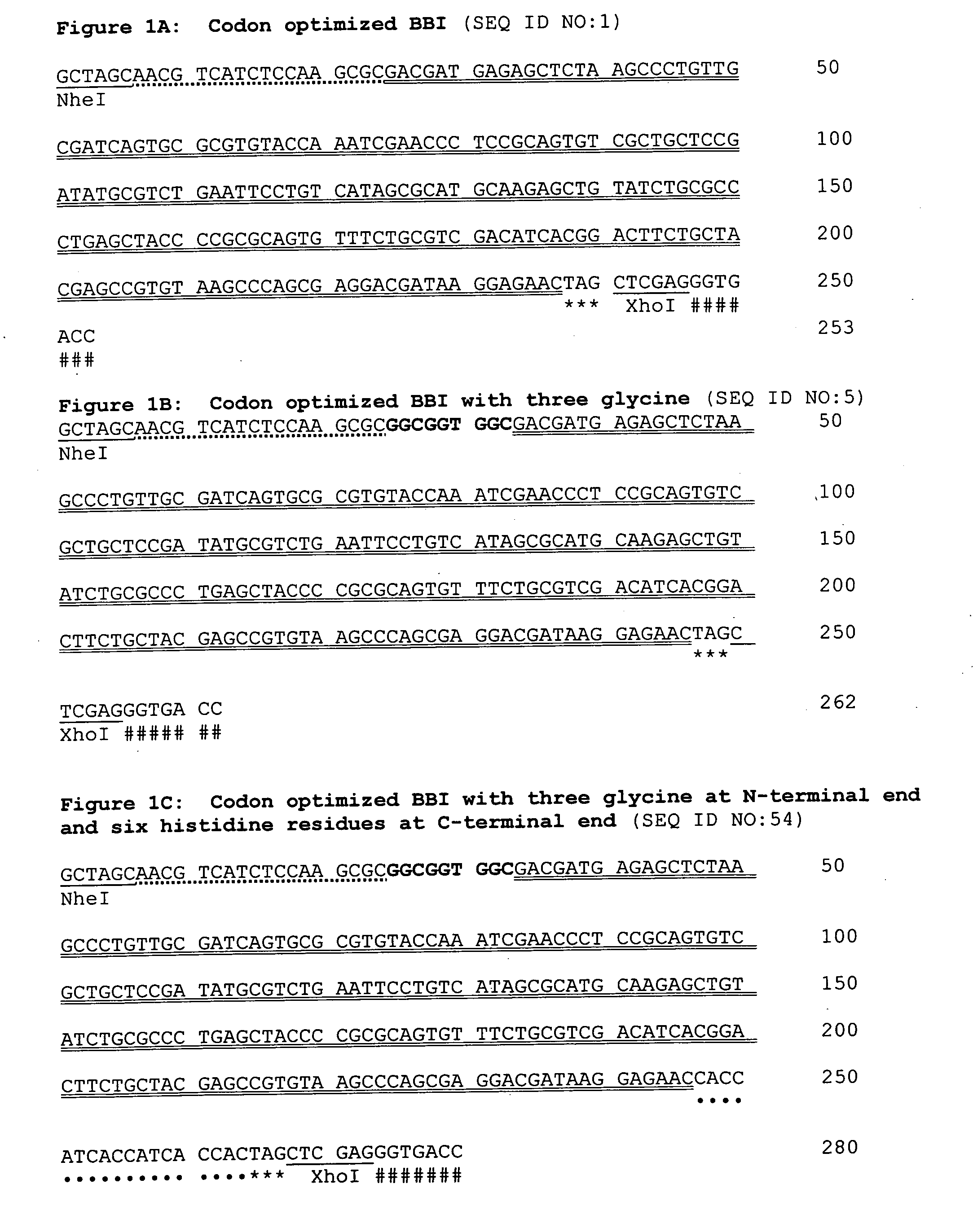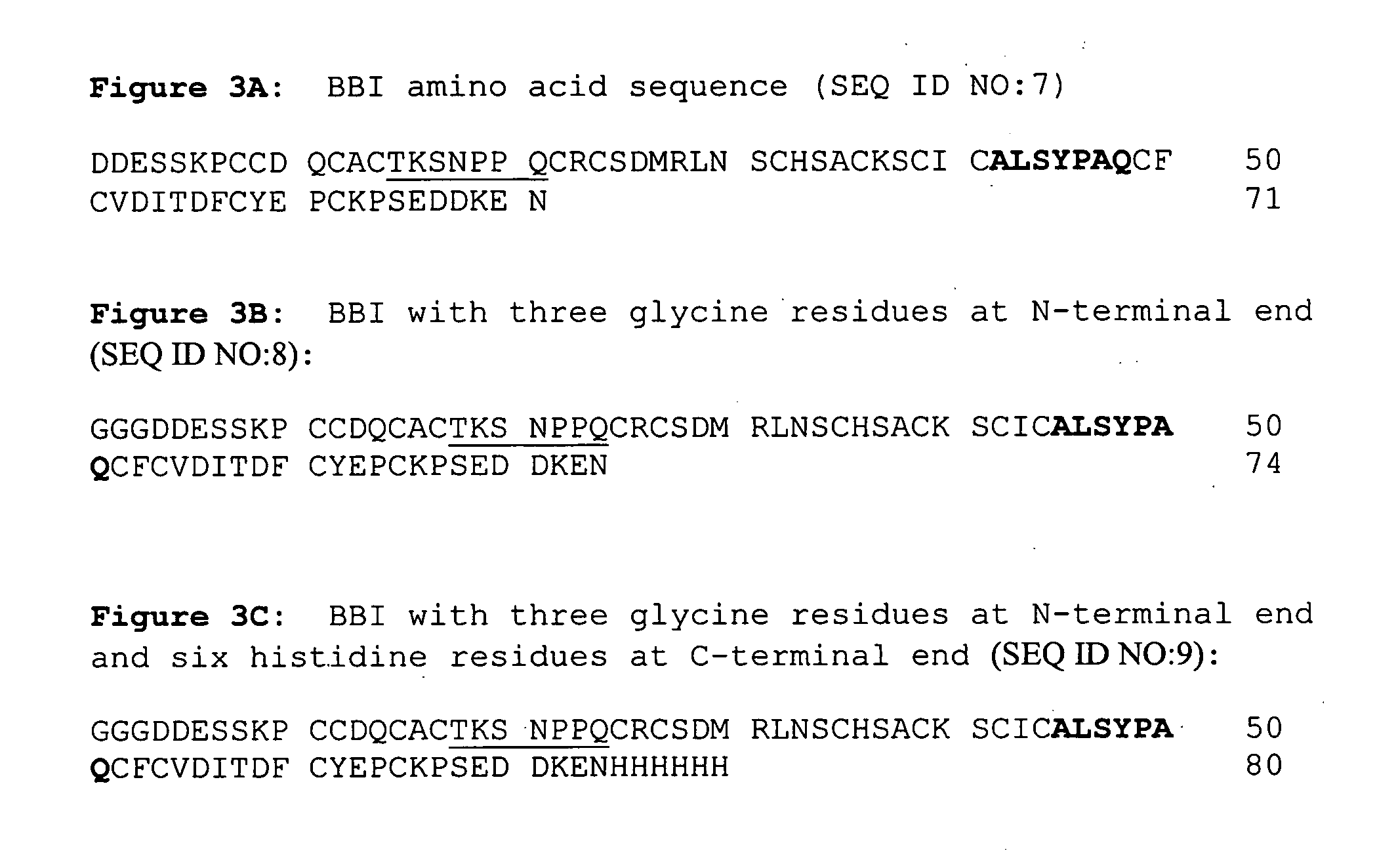Expression in filamentous fungi of protease inhibitors and variants thereof
a technology of protease inhibitors and filamentous fungi, which is applied in the direction of endopeptidase, peptide sources, applications, etc., can solve the problems of inability to isolate natural protease inhibitors for clinical applications, and inability to inhibit protease inhibitors' action
- Summary
- Abstract
- Description
- Claims
- Application Information
AI Technical Summary
Problems solved by technology
Method used
Image
Examples
example 1
Cloning of DNA encoding the Soybean Trypsin Inhibitor
[0155] This example illustrates the development of an expression vector for STI.
[0156] In general, the gene encoding the desired protein was fused to the DNA encoding the linker region of glucoamylase with an engineered kexB cleavage site (NVISKR) via an NheI restriction enzyme site at the N-terminal and a BstEII restriction enzyme site at the C-terminal following the STI stop codon, TAG. The gene encoding the soybean STI was synthesized by MCLAB (South San Francisco, Calif.) in vitro as a DNA fragment containing two restriction sites, a kexB cleavage site and three glycine residues at N-terminal end and six histidine residues at C-terminal end. (SEQ ID NO:3, gene shown in FIG. 2). All PCR-generated DNA fragments used herein were initially cloned into the pCRII-TOPO vector (Invitrogen, Carlsbad, Calif.). E. coli [One Shot® TOP10 cells from Invitrogen], was used for routine plasmid isolation and plasmid maintenance. The NheI and ...
example 2
Codon Optimization of the DNA Encoding the Soybean Trypsin Inhibitor
[0163] The following example details how the STI-encoding DNA was altered for optimized expression in a filamentous fungi.
[0164] The codons from the synthetic gene (the starting material in Example 1 that was synthesized by MCLAB) were then optimized according to the codon usage of highly expressed proteins in Aspergillus. Basically, proteins that expressed well such as glucoamylase, alpha-amylase and prochymosin were compared to proteins that did not express well in Aspergillus such as human NEP and DPP4. See Table I. The codon usage table for both types of protein expressions in Aspergillus is in Table II.
TABLE IIglucoamylaseNEPbovineHer2Stachybotrysstachybotrysw / out starch CodonAAcodingDPP4SCCEprochymosinchymotrypsinLight chainoxidase Boxidase Abinding domaingca*Ala(A)191510112410gccAla(A)126815178192318gcgAla(A)120112109gcuAla(A)18122133252120---Ala(A)503511172214474857aga*Arg(R)15163102221aggArg(R)584641451...
example 3
Expression of the Bowman-Birk Inhibitor and its Variants in Aspergillus
a. BBI Fusion to Glucoamylase with kexB Site and with Three Glycine at N-Terminal End and Six Histidine Residues at C-Terminal:
[0169] Following procedures described in Example 2 above, the BBI-encoding DNA was optimized and used for this Example. The DNA was synthesized by MCLAB in vitro as a DNA fragment containing three restriction sites (NheI at 5′ end of gene and XhoI and BstEII at the 3′ end), a kexB cleavage site and three glycine residues at N-terminal and six histidine residues at C-terminal. (SEQ ID NO:54). It was cloned into pCRII-TOPO vector Invitrogen. Following procedures described in Example 1 above, the NheI to BstEII fragment was released from the plasmid by restriction digestion and the DNA fragment was extracted from agarose gel and cloned into pSLGAMpR2 to create expression plasmid pSLGAMpR2-BBlkex+(Q104). The expression plasmid was transformed into dgr246ΔGAP:pyr2. The transformation and sh...
PUM
| Property | Measurement | Unit |
|---|---|---|
| temperature | aaaaa | aaaaa |
| temperature | aaaaa | aaaaa |
| pH | aaaaa | aaaaa |
Abstract
Description
Claims
Application Information
 Login to View More
Login to View More - R&D
- Intellectual Property
- Life Sciences
- Materials
- Tech Scout
- Unparalleled Data Quality
- Higher Quality Content
- 60% Fewer Hallucinations
Browse by: Latest US Patents, China's latest patents, Technical Efficacy Thesaurus, Application Domain, Technology Topic, Popular Technical Reports.
© 2025 PatSnap. All rights reserved.Legal|Privacy policy|Modern Slavery Act Transparency Statement|Sitemap|About US| Contact US: help@patsnap.com



